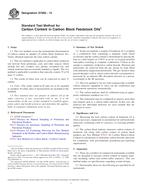We need your consent to use the individual data so that you can see information about your interests, among other things. Click "OK" to give your consent.
ASTM D6450-12e1
Standard Test Method for Flash Point by Continuously Closed Cup (CCCFP) Tester (Includes all amendments And changes 7/6/2016).
Automatically translated name:
Standard Test Method for Flash Point by Continuously Closed Cup (CCCFP) Tester
STANDARD published on 1.12.2012
The information about the standard:
Designation standards: ASTM D6450-12e1
Note: WITHDRAWN
Publication date standards: 1.12.2012
SKU: NS-35188
The number of pages: 7
Approximate weight : 21 g (0.05 lbs)
Country: American technical standard
Category: Technical standards ASTM
The category - similar standards:
Annotation of standard text ASTM D6450-12e1 :
Keywords:
continuously closed cup, flammability, flash point, ICS Number Code 75.080 (Petroleum products in general)
Additional information
| Significance and Use | ||||||||||||||
|
5.1 The flash point temperature is one measure of the tendency of the test specimen to form a flammable mixture with air under controlled laboratory conditions. It is only one of a number of properties that must be considered in assessing the overall flammability hazard of a material. 5.2 Flash point is used in shipping and safety regulations to define flammable and combustible materials and classify them. This definition may vary from regulation to regulation. Consult the particular regulation involved for precise definitions of these classifications. 5.3 This test method can be used to measure and describe the properties of materials in response to heat and an ignition source under controlled laboratory conditions and shall not be used to describe or appraise the fire hazard or fire risk of materials under actual fire conditions. However, results of this test method may be used as elements of a fire risk assessment, which takes into account all of the factors that are pertinent to an assessment of the fire hazard of a particular end use. 5.4 Flash point can also indicate the possible presence of highly volatile and flammable materials in a relatively nonvolatile or nonflammable material, such as the contamination of lubricating oils by small amounts of diesel fuel or gasoline. |
||||||||||||||
| 1. Scope | ||||||||||||||
|
1.1 This flash point test method is a dynamic method and depends on definite rates of temperature increase. It is one of the many flash point test methods available, and every flash point test method, including this one, is an empirical method. 1.2 This test method covers the
determination of the flash point of fuel oils, lube oils, solvents,
and other liquids by a continuously closed cup tester. The
measurement is made on a test specimen of 1 mL.
1.3 This test method utilizes a closed but unsealed cup with air injected into the test chamber. 1.4 This test method is suitable for testing samples with a flash point from 10 to 250°C. 1.5 If the user's specification
requires a defined flash point method other than this test method,
neither this test method nor any other method should be substituted
for the prescribed method without obtaining comparative data and an
agreement from the specifier.
1.6 The values stated in SI units are to be regarded as standard. No other units of measurement are included in this standard. Temperatures are in degrees Celsius, and pressure is in kilo-pascals. 1.7 This standard does not
purport to address all of the safety concerns, if any, associated
with its use. It is the responsibility of the user of this standard
to establish appropriate safety and health practices and determine
the applicability of regulatory limitations prior to use.
Standard Practice for Determination of
Precision and Bias Data for Use in Test Methods for Petroleum
Products, Liquid Fuels, and Lubricants Standard Practice for Sampling Industrial
Chemicals ISO Guide 34 Standard Practice for Manual Sampling of
Petroleum and Petroleum Products Standard Practice for Automatic Sampling
of Petroleum and Petroleum Products (Includes all amendments and
changes 3/24/2023). ISO Guide 35 Reference materialsGeneral and
statistical principles for certification Standard Practice for Applying
Statistical Quality Assurance and Control Charting Techniques to
Evaluate Analytical Measurement System Performance (Includes all
amendments and changes 12/12/2023). |
Similar standards:
Historical
15.2.2010
Historical
1.11.2013
Historical
1.11.2013
Historical
15.2.2011
Historical
1.6.2012
Historical
1.5.2013
We recommend:
Technical standards updating
Do you want to make sure you use only the valid technical standards?
We can offer you a solution which will provide you a monthly overview concerning the updating of standards which you use.
Would you like to know more? Look at this page.



 ASTM D7578-10e1
ASTM D7578-10e1 ASTM D7662-13
ASTM D7662-13 ASTM D7679-13
ASTM D7679-13 ASTM D7683-11
ASTM D7683-11 ASTM D7776-12
ASTM D7776-12 ASTM D7777-13
ASTM D7777-13
 Cookies
Cookies
